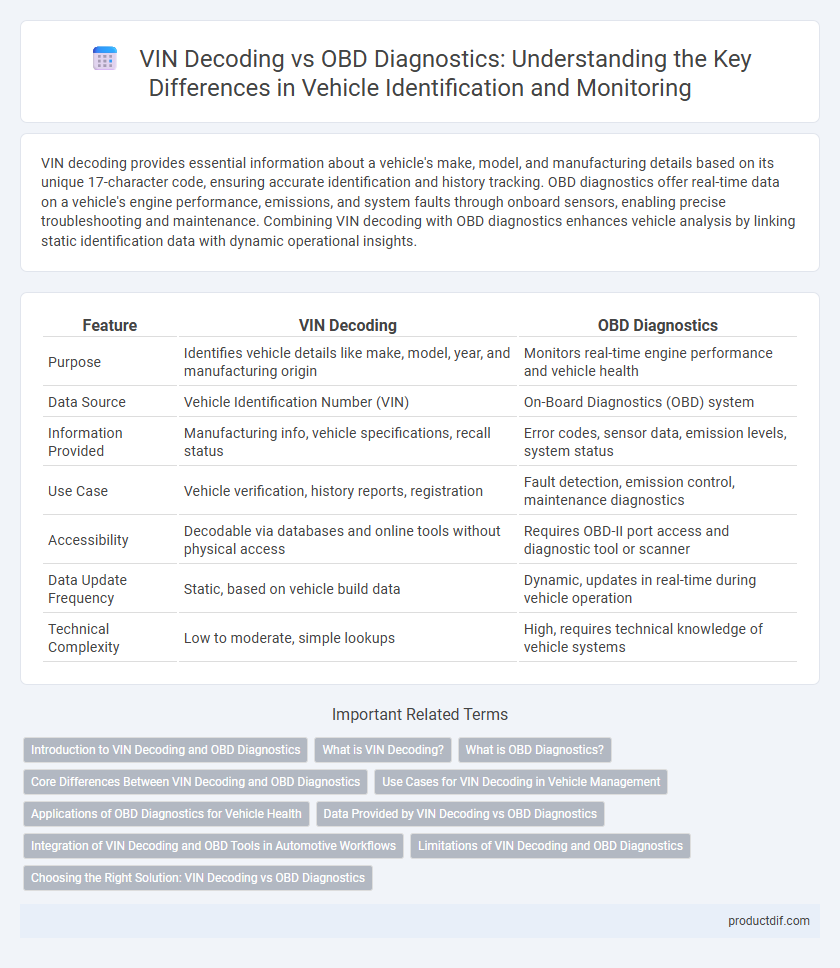VIN decoding provides essential information about a vehicle's make, model, and manufacturing details based on its unique 17-character code, ensuring accurate identification and history tracking. OBD diagnostics offer real-time data on a vehicle's engine performance, emissions, and system faults through onboard sensors, enabling precise troubleshooting and maintenance. Combining VIN decoding with OBD diagnostics enhances vehicle analysis by linking static identification data with dynamic operational insights.
Table of Comparison
| Feature | VIN Decoding | OBD Diagnostics |
|---|---|---|
| Purpose | Identifies vehicle details like make, model, year, and manufacturing origin | Monitors real-time engine performance and vehicle health |
| Data Source | Vehicle Identification Number (VIN) | On-Board Diagnostics (OBD) system |
| Information Provided | Manufacturing info, vehicle specifications, recall status | Error codes, sensor data, emission levels, system status |
| Use Case | Vehicle verification, history reports, registration | Fault detection, emission control, maintenance diagnostics |
| Accessibility | Decodable via databases and online tools without physical access | Requires OBD-II port access and diagnostic tool or scanner |
| Data Update Frequency | Static, based on vehicle build data | Dynamic, updates in real-time during vehicle operation |
| Technical Complexity | Low to moderate, simple lookups | High, requires technical knowledge of vehicle systems |
Introduction to VIN Decoding and OBD Diagnostics
VIN decoding reveals essential vehicle information such as make, model, year, and manufacturer details by analyzing the 17-character Vehicle Identification Number. OBD diagnostics, on the other hand, access real-time data from a vehicle's onboard computer to detect engine and emission-related issues through standardized trouble codes. Combining VIN decoding with OBD diagnostics enhances vehicle identification accuracy and enables precise monitoring of mechanical and electronic system performance.
What is VIN Decoding?
VIN decoding is the process of interpreting the 17-character Vehicle Identification Number to reveal specific information about a vehicle's make, model, year, manufacturer, and place of assembly. This unique identifier provides critical details for vehicle registration, history reports, and parts compatibility without accessing live engine data. Unlike OBD diagnostics that monitor real-time performance and fault codes, VIN decoding offers static but essential vehicle background information.
What is OBD Diagnostics?
OBD diagnostics, or On-Board Diagnostics, is a standardized system in vehicles that monitors and reports the performance of critical engine components and emissions control systems through a diagnostic trouble code (DTC) interface. It provides real-time data and error codes from the vehicle's engine control unit (ECU), enabling technicians to identify malfunctions and optimize repairs efficiently. Unlike VIN decoding, which reveals the vehicle's manufacturing details, OBD diagnostics offers a dynamic insight into the vehicle's operational status and health.
Core Differences Between VIN Decoding and OBD Diagnostics
VIN decoding provides essential vehicle information such as make, model, year, and manufacturer by interpreting the standardized Vehicle Identification Number, enabling identification without physical inspection. OBD diagnostics involve accessing the vehicle's onboard computer system to read real-time data and trouble codes related to engine performance, emissions, and system malfunctions. The core difference lies in VIN decoding offering static identification details, while OBD diagnostics deliver dynamic, actionable insights for vehicle maintenance and repair.
Use Cases for VIN Decoding in Vehicle Management
VIN decoding enables vehicle managers to quickly access detailed information about a vehicle's make, model, year, and manufacturing details, which is crucial for accurate vehicle identification and history tracking. It supports inventory management, warranty claims, and insurance verification by providing standardized and comprehensive data from the 17-character VIN. Unlike OBD diagnostics that focus on real-time engine and sensor data, VIN decoding is essential for administrative tasks such as fleet registration, recall management, and verifying vehicle specifications during maintenance planning.
Applications of OBD Diagnostics for Vehicle Health
OBD diagnostics enables real-time monitoring of engine performance, emission systems, and sensor data, providing essential insights into vehicle health and fault detection. It supports preventive maintenance by identifying issues before they result in major failures, thereby enhancing safety and reducing repair costs. The ability to read and clear diagnostic trouble codes (DTCs) allows mechanics and vehicle owners to quickly address problems and maintain optimal vehicle operation.
Data Provided by VIN Decoding vs OBD Diagnostics
VIN decoding provides static information such as vehicle make, model, year, engine type, and manufacturing details, essential for vehicle identification and history tracking. OBD diagnostics deliver real-time data on engine performance, emission control systems, sensor statuses, and fault codes, enabling precise troubleshooting and maintenance. Combining both data sources enhances vehicle diagnostics by offering comprehensive insights from manufacturing specifics to current operational conditions.
Integration of VIN Decoding and OBD Tools in Automotive Workflows
Integrating VIN decoding with OBD diagnostics streamlines automotive workflows by enabling precise vehicle identification alongside real-time system monitoring. This combination allows technicians to access accurate vehicle specifications, recall information, and maintenance history directly from the VIN, while simultaneously reading live data and fault codes through OBD tools. The synergy of VIN decoding and OBD diagnostics enhances troubleshooting efficiency, reduces diagnostic errors, and supports targeted repairs in automotive service environments.
Limitations of VIN Decoding and OBD Diagnostics
VIN decoding provides essential vehicle information such as manufacturer, model, and production year but cannot capture real-time mechanical or sensor data. OBD diagnostics offer detailed insights into engine performance and error codes but are limited to powertrain and emissions systems, unable to reveal historical or manufacturing details embedded in the VIN. Combining both tools enhances vehicle analysis, yet each has distinct limitations in scope and data depth.
Choosing the Right Solution: VIN Decoding vs OBD Diagnostics
VIN decoding provides comprehensive vehicle history, manufacturer details, and specifications by interpreting the Vehicle Identification Number, perfect for assessing car authenticity and ownership history. OBD diagnostics retrieves real-time data on engine performance, emission levels, and fault codes, essential for pinpointing mechanical issues and ensuring vehicle safety. Choosing between VIN decoding and OBD diagnostics depends on whether the priority is vehicle verification or in-depth mechanical analysis.
VIN decoding vs OBD diagnostics Infographic

 productdif.com
productdif.com